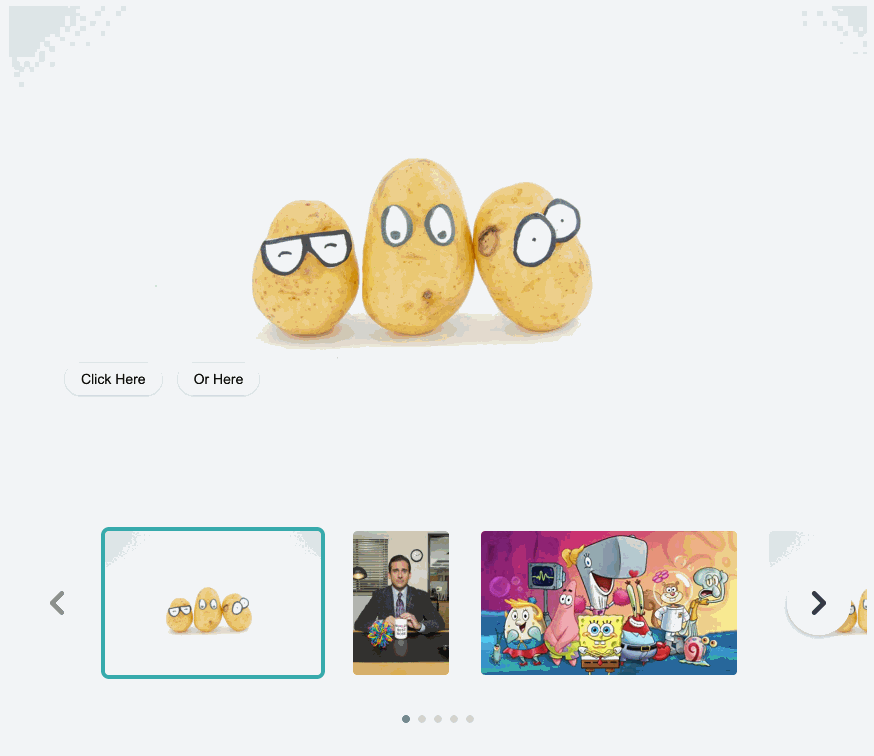@lifeway/carousel v0.2.2
Carousel
A reusable, responsive, and adaptive carousel for react
:tada: Demo

:memo: Getting Started
This package is on npm: @lifeway/carousel :fire:
:zap: Installation
npm install @lifeway/carouselThere are several peer dependencies that must be added to your project (if you do not already have them):
npm install react@^16.8.0 styled-components@^5.1.0For more information on peer dependencies, please refer to the npm docs (here).
Also, this package uses the newer Web APIs IntersectionObserver and ResizeObserver.
If you are planning on using this in an older browser environment (I'm looking at you IE! :eyes:) then you'll need to polyfill them or the carousel won't work right.
For reference, here are the compatibility charts for IntersectionObserver and ResizeObserver
:notebook: Usage
This is basically the code for the demo screenshot at the top of the readme:
import { Carousel, SingleCarousel, ImageTile } from '@lifeway/carousel';
const items = [
{ name: 'Thing 1', image: 'url-to-image-of-thing-1' },
{ name: 'Thing 2', image: 'url-to-image-of-thing-2' },
{ name: 'Thing 3', image: 'url-to-image-of-thing-3' }
];
const MyComponent = () => {
const [selected, setSelected] = useState(0)
return (
<div>
<SingleCarousel selected={selected} onSelect={setSelected}>
{items.map(item => (
<img key={item.name} src={item.image} alt={item.name} />
))}
</SingleCarousel>
<Carousel selected={selected} onSelect={setSelected}>
{items.map(item => (
<ImageTile key={item.name} src={item.image} alt={item.name} />
))}
</Carousel>
</div>
);
}All of the source is built with typescript so it all has intellisense :fire:
This package also exports a number of hooks (both high-level and low-level) which can be used to build your own carousel component! In fact, all of the components' logic is encapsulated in the hooks, and the components just wire the hooks up to the dom elements.
More complete docs will (hopefully) be coming soon :rocket:
:computer: Development
This project uses Storybook for developing UI components & Jest for running tests.
Simply install the dependencies and you are ready to go!
npm install:open_book: Storybook
Run storybook locally using the start command:
npm startYou can also build a static version of storybook if you really want to:
npm run storybook:build:robot: Tests
This project uses the philosophy of favoring integration tests over unit tests (as championed by Kent C Dodds :trophy:).
All integration tests live in the src/__integration_tests__ folder, with the test file named [feature].spec.js.
All unit tests are co-located with the corresponding source file in a __tests__ folder, with the test file named [file].spec.js.
There are several npm scripts to run tests, with npm test being the main one (rather obviously :P)
npm test # run the unit/integration tests for development
npm run test:ci # run the unit/integration tests for use in a CI environment
npm run test:coverage # run the unit/integration tests with coverage
npm run test:watch # run the unit/integration tests in watch mode
npm run test:visual # runs the visual testsNote: The visual tests require the environment variable APPLITOOLS_API_KEY.
:trophy: Validation
There are several npm scripts that are used to check the "health" of the current commit:
npm run build:check # check that everything type checks & builds properly
npm test # run the unit/integration tests
npm test:visual # runs the visual tests
npm run lint # lints the codebase
npm run audit # check for security vulnerabilities
# or npm audit
npm run validate # runs all of the above checksAll of these checks (or variants thereof) are run on PRs, since we want to keep the repo healthy! :muscle:
:fire: Publishing a New Version
To create a new version, simply run:
npm version [patch/major/minor]And don't forget to update the CHANGELOG (mark the "unreleased" changes with the version number & date).
The CI will automatically publish the new version to NPM, so you just have to make a PR & let the CI do it's thing!
If for some reason you need to manually publish this package, please triple-check that everything is updated (CHANGELOG in particular) & working (use npm run validate),
and then just run the following:
npm login
npm publish

